Glass apron for kitchen: how to choose and install?
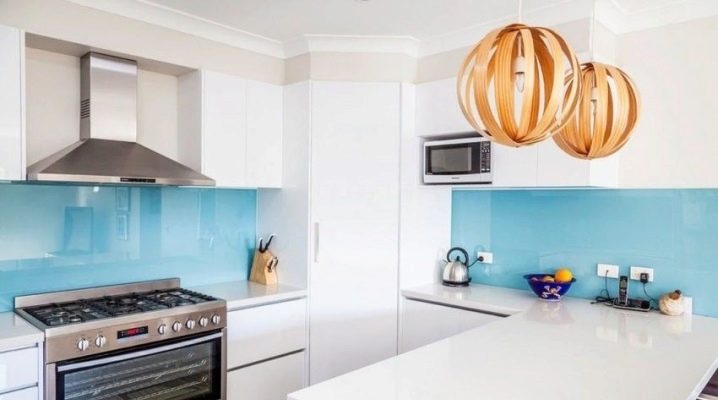
Kitchen aprons set the tone for the entire kitchen. This is the hostess's working area, which is constantly exposed to water in the area of the sink or oil and grease stains in the area of the stove. Therefore, they always tried to make this section of the wall so that it was possible to quickly remove the consequences of cooking and washing dishes.
For these purposes, a moisture resistant paint was used. Then this part of the kitchen was firmly occupied by ceramic tiles. Now at the peak of popularity are glass kitchen aprons, which look very aesthetically pleasing, bright and fashionable.






Advantages and disadvantages
A kitchen apron is usually called a part of the wall between the countertop, gas or electric stove, wall cabinets and a sink for washing dishes. A glass apron has several advantages.
These panels are in keeping with the modern spirit of designer fashion and are suitable for the following styles:
- Scandinavian;
- neoclassicism;
- art deco;
- modern;
- minimalism;
- high tech.
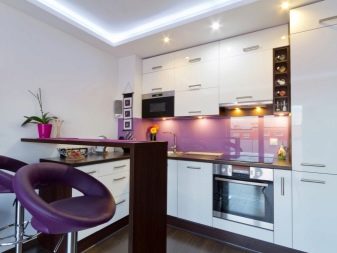

Glass goes well with modern materials from which furniture is now made. It is ideal for glass and chrome household appliances. Fast installation is a big plus. There are no consequences in the kitchen after the installation work, which can last from 1 to 2 hours.
The panels do not have seams and do not cause any particular problems in their care. Glass visually enhances the kitchen space thanks to its brilliance.



The owners of such a kitchen have a wide scope for imagination, how and what to decorate glass panels. For example, it can be photo printing, stereo printing, sandblasting drawing, vinyl monochromatic substrate. The glass surface itself can be matte or have a textured structure.
If the walls are made of wood or stone, then glass can enhance the beauty of the material. In this case, a transparent panel is used. Sometimes wallpaper or walls are left under such glass, and in general the kitchen looks in one color scheme.
The backlight is the perfect companion for a glass backsplash. Its soft light is stratified throughout the kitchen, creating a cozy atmosphere.



But with all this, glass panels have their own characteristic drawbacks. Price comes first. Not everyone can afford such a kitchen decor - the average cost of a tempered glass apron can be over 5 thousand rubles per 1 sq. m.
The price can be influenced by the individual design of the customer and the use of additional mounts, installation of lighting, additional footage. The price rises several times.


The apron is installed only after the complete assembly of the kitchen unit and the connection of all communications... It is impossible to remake glass panels, and if the owners of the kitchen do not like their design, then it is easier to make new ones. Therefore, at the initial stage, great importance is attached to the design solution. The selected pattern may not be combined with the interior of the kitchen, overload it in color, or quickly become familiar.
The production time for a glass apron can take from 1 to 2 weeks.
The glass backsplash is not suitable for all kitchens. For example, if the interior is designed in a classic style, Provence or country, then ordinary ceramic tiles will still be the best solution for an apron.

Types of material
The main requirement for a kitchen apron is resistance to water and temperature resistance up to +150 degrees.
There are several types of materials from which glass panels are made.
- Stalinite... Ordinary glass is heat treated at a very high temperature, then it is rapidly cooled. Thus, its shock resistance increases by 10 times when compared with ordinary glass. In the event of a blow, the stalinite crumbles into several pieces, which will not pose any danger to humans. He is not afraid of household chemicals and abrasive substances. The service life of tempered glass reaches 10 years.
You cannot make additional holes in the finished panel for household appliances. This work should be done before glass tempering. It is worth noting that a solid stalinite panel should have a thickness of 6 mm. If less, then such glass will require a more careful attitude.



- Laminated glass... An apron made of this material has another name - triplex. This is the name of a multilayer glass structure, the layers of which are connected with a special polymer. In the event of an impact, the glass does not shatter, but remains on the film. Triplex panels are 8 mm thick. With the help of a polymer film, panels can find any decor. Such glass does not require any special maintenance. For the price, such glass is one of the most expensive, by weight - one of the heaviest. It is produced within 1 month.
There are practically no restrictions on the decor - it can be photo-printed, it is perfectly decorated with a fabric or leather base. The surface of the triplex can be matte or painted. Laminated glass can be made under a mirror or foil.



- Plexiglass... One of the main advantages of this material is its shock resistance. It has good flexibility and light weight. Plexiglas is good for decorating walls with small errors. The material allows you to work with it after installation, for example, if you need additional space for sockets. Making plexiglass panels does not take much time.
This material does not tolerate high temperatures - maximum +80 degrees, so installation above the hob is not recommended. Often such panels are covered with tempered glass, since they do not like processing with household chemicals.


- Polycarbonate... This material is similar to plexiglass, but is more suitable in terms of its qualities for a kitchen backsplash. It costs significantly less than other types of materials, tolerates higher temperatures, bends well and is light in weight. From polycarbonate, a good home craftsman can install the panel on his own.
But the material loses outwardly to ordinary glass. Numerous scratches can often be found on its surface.

Stalinite is offered in the following versions:
- stemalitis - this is the name of the glass that was painted before it was hardened;
- satin - glass with frosted surface;
- skinned - glass with decorative design;
- optimize - the glass surface is subjected to additional bleaching; used when working with drawings for color rendering.



When printing photographs, you can choose the appropriate picture that will affect the overall mood of the kitchen. Glass aprons with fruits, dishes, drinks look beautiful. The “urban” style of photo printing will emphasize the modernity of high-tech design. You can take a 3D photo.
Designers do not recommend making aprons with multiple images. It is better to choose one drawing that will make the kitchen modern and cozy.
Before photo printing, the glass is prepared, the necessary holes are cut out on it. Then, with the help of special equipment, a pattern is applied, which is covered with a protective layer.



The glass apron can be made to match the mosaic or left in plain color. The main thing is that outwardly the kitchen does not lose its individuality and pleases the owners of the house or apartment. Backlighting will only enhance the overall impression of the glass apron and the interior of the room., will make the drawing brighter and emphasize the elements of the typeface.
The LED strip is installed around the perimeter of the entire panel or inside it, excellent illumination of the work surface is obtained.
You can do without turning on the main light on the room, in this case colored backlighting or white is used... Often, backlighting is done in the side parts of the panels. Sometimes it is installed in the end parts of the apron. This option is suitable for modern kitchen interiors.

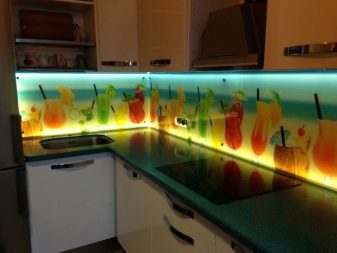



Selection Tips
General rules for combining colors allow customers to determine the desired color, namely:
- for a classic kitchen, an apron in a contrasting bright color may be an ideal solution; as a rule, the classics combine two colors - white and black;
- if the interior is designed in light green color, then a green apron is best suited;


- a cream kitchen will go well with a lilac apron; the same with the pink interior kitchen;
- any color is suitable for a white kitchen - for energetic people, the best solution will be skins with bright images - these can be birds, berries, and even your own drawing; sophistication to a white interior can be given by a golden pattern on a mirror surface.



There are no advisers in this matter. The main thing is the taste of the owners. Designers will give advice on how to choose the right color that will be in harmony with the overall look of the kitchen. Experts advise when choosing a design, it is better to take ready-made solutions.
The manufacturer will show you what a glass backsplash looks like in already made kitchens. As a rule, there is an extended portfolio for such cases.
For heat-resistant glass panels, color and pattern do not lose their properties throughout the entire period of operation.



Installation Recommendations
Before installing, it is necessary to measure the area for the future kitchen apron. They are produced only after surface finishing and installation of a kitchen set. When measuring, it must be taken into account that the panel will go under the kitchen wall cabinets by 20 cm in order to hide the fasteners. It is also important to consider the shape of the apron itself. It can have a curved structure, in this case, it is better to provide measurements to specialists.
If the skins are planned to be placed on different surfaces, the entire length of the panel is measured. For a trapezoidal panel, all horizontal and vertical lines are measured.
Aprons are made from a single sheet, so great attention is paid at the preparation stage to the dimensions of doorways and the width of the stairs in multi-storey buildings.
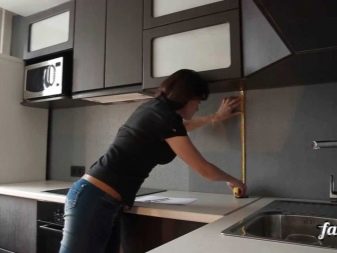

The standard sizes of a decorative kitchen panel are as follows:
- height - from 40 to 90 cm;
- length - no more than 2.5 meters.
Larger kitchens will require a longer apron. Experts recommend making it from component parts, since the joints between them are invisible.


There are three options for fixing the panels.
- On screws... The panel fastening with screws is suitable for any wall surface. It is considered the most practical. Screw caps are placed on the screw caps. At any time, you can remove the panel from the wall by twisting the fasteners.
- Hinged fasteners... If the apron consists of several parts, then the hinged fasteners are best suited. They will allow you to dock the parts more evenly and accurately.
- Liquid nails or glue... The decorative panel is fixed with liquid nails or glue only on plastered and leveled walls. The appearance of such an attachment makes it invisible. If the apron is composite, then the seams are treated with a sealant.


You can install the panels yourself. The easiest way to do this is screw mounting.
It is produced in the following way:
- before starting work, the surface of the wall is put in order: it must be flat and putty;
- it is imperative to de-energize the sockets and dismantle them;
- the glass is applied to the wall and the attachment points are marked on it;
- the marks need to be drilled;
- gaskets should be installed in the panel, and embedded elements in the wall;
- then the apron is attached with dowel-nails to the wall; fasteners must be closed with decorative covers;
- after all the work, work is performed on the sockets - installation of the cover.



For information on how to install a glass apron, see the next video.
Care
It is very easy to care for a glass apron. Just like behind plain glass. It should be noted that the panels get dirty quickly, this is especially noticeable in the work area where food is prepared - drops of grease and dirt remain on the glass.
In the place of the sink, on the panel, you can see the barely noticeable traces of dried drops from water. This circumstance does not mean minus glass at all. Such phenomena can be seen both on ceramic tiles and on ordinary painted kitchen walls.


To clean the skinny, you need to follow three rules.
- To clean the glass apron, you will need conventional mirror and glass detergents. Before applying them to the surface, you need to clean it from dust with a dry cloth. So that there is no divorce after the product, you must first wipe the glass clockwise, and then make the same movements against. Then the surface of the panel is rubbed dry with a rag with vertical and horizontal movements.
- Only soft tissues or tissue napkins should be used in stonecrop. Do not remove grease with metal sponges; scratches will remain on the surface. Fat is well removed with modern detergents.
- Do not use alcohol or abrasive detergents when caring for the panel.
The picture or photograph is reliably protected by glass, as they are located on the back of the panel. They are not affected by direct sunlight. It is recommended to clean the glass apron once a day. Best of all, after completing all household chores.


Reviews
Reviews of glass aprons can be found the most controversial. Someone thinks that the use of ceramic tiles is the most practical. Indeed, this material still does not give up its positions in the consumer market, remaining one of the materials in demand.
Manufacturers are trying to keep up with the times, offering tiles of a wide variety of designs. But still, wall panels have much more design possibilities. Photo printing allows you to apply a variety of patterns, which means that you can choose any design for the kitchen. Glass significantly expands the space of the room, it can be installed in both large and small kitchens.
There is an opinion that if the panel is made of glass, it means that it breaks. Tempered glass is capable of withstanding human weight, and even impacts.
When installing, you must comply with the requirements. Panels are installed only on flat walls... If the installer drags the panel somewhere, the glass may crack. There really are such concerns, especially if you do the installation yourself. It is better to entrust this work to specialists.



Most often, buyers ask if the glass is dirty, because not only drops of water and fat remain on it, but also fingers. If you do not take care of the glass, then sooner or later it will lose its original appearance. Any surface requires attention and care.
So it is here - glass aprons require a little more attention. It is enough to wipe them once every day in the working area... But in terms of design, there are no restrictions.
Important! There are much more good and positive reviews. Still, such panels in the kitchen cause aesthetic pleasure, cheer up and make the home kitchen modern.


There is an opinion that such aprons in the kitchen have passed from the category of sophistication to mass production. They are installed everywhere and in any city. Because of this, glass aprons began to become boring to the townsfolk. Any successful design idea immediately goes to the masses. This is normal, as is the desire for a beautiful and cozy home.Such panels are one of the suggestions to achieve what you want.
Many are afraid of the price. There is always room for the price run up and down. It all depends on the material used, accessories, additional services. You can always replay the price in your favor by replacing one type of design with another.


Interesting examples
Skinny design largely depends on the wishes of the customer. The easiest option, which is often offered, is to install panels made of ordinary glass. There is no question of decorative purpose here. Thus, you can solve the problem with the protection of the wallpaper.
Experts recommend making such panels matte, which will give them sophistication. You can apply sandblasting drawings - it can be some kind of inscriptions or wishes, which looks very impressive.


Tinted glass can be an ideal solution for rooms with many colors. The paint is applied to the back of the panel. Drawings can be very different, including abstraction. In terms of color, the choices are endless.
The most popular type is panels with a full color pattern. It can be a perspective view or a 3D drawing. This method makes the kitchen not only original in design, but also exclusive. The second one can hardly be found. Thanks to such drawings, the room looks much larger than it actually is.


It is best if the image is applied using photo printing, because it remains the highest quality.
You can choose a budget option - apply the image using vinyl film. But in this case, there is a risk that the film will lose its properties and eventually fade or peel off.
A printed apron costs 50 percent more than plain glass or vinyl. Printing a 3D drawing will increase the cost of work by another 2.5 times.
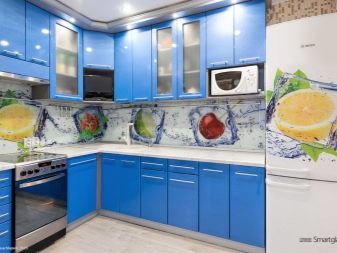

Another an interesting design option are mirrored aprons... It is the perfect solution for small kitchens. It is known that a mirror visually changes the space of a room, the geometry of narrow rooms changes.
Designers offer a wide variety of solutions. You can decorate the mirror apron with a pattern, tint the surface or age it. The combination of mirror panels looks unusual.

Glass aprons continue to attract attention. Clients choose them for their unique design and the opportunity to make their kitchen brighter and more modern. Such panels will last a very long time. They are not afraid of moisture or heat. They will retain their shine, rich color and tone of colors for many years.
Family members, friends and close people usually gather at the kitchen table, and the cozy interior makes such meetings even more sincere.














The comment was sent successfully.